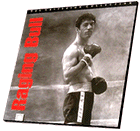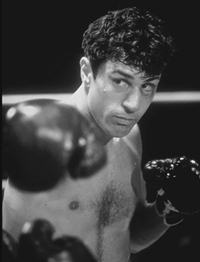

USA drama
1980
color 128 min.
Director: Martin Scorsese
CAV: out-of-print collectible
3 discs, catalog # CC1230L
CLV: out-of-print collectible
2 discs, catalog # CC1238L

When two different critics polls cited Raging Bull as the greatest film of the 1980s, it was the final confirmation of what many film lovers had come to suspect for some time. As a decade marked mainly by the cheapest sort of slam-bang popcorn thrills raced to a close, the images and sounds of Martin Scorsese's searing biopic of the life and times of boxer Jake La Motta seemed sharper and more meaningful than ever. Charged by Robert De Niro's overwhelming, Oscar-winning portrayal of the former middle-weight champion, Raging Bull had become a classic.
From the hard-bitten cynicism of The Set-Up, to the romanticism of Body and Soul, the sentiment of Somebody Up There Likes Me, and the pure fantasy of the Rocky series, boxing dramas have always been a Hollywood mainstay. Still, prior to its 1980 release, no one had ever seen a film about the sport that was remotely like Raging Bull. For in looking beyond the surface "realism" of the past, Scorsese -- aided by Michael Chapman's brilliant black-and-white photography, Frank Warner's dense sound design, and Thelma Schoonmaker's crisp editing (another Oscar winner) -- lets us know exactly what it's like to be inside a boxing ring with a hailstorm of body blows raining down on us. But technique alone doesn't set Raging Bull apart from all other boxing dramas. The film's real difference is its subject -- Jake La Motta.
A fighter noted less for his technique than his ability to inflict physical punishment on his opponents, La Motta was once banned from the sport for throwing a fight. His life outside of sports was no less unsettled, marked by stormy marriages and brief imprisonment on a morals charge. In short, we're far from the heroic likes of Joe Palooka.
"What could be more basic than making a living hitting another person on the head until one of you falls or stops?" Scorsese remarked to a British National Film Theatre audience. "I was fascinated by the self-destructive side of Jake La Motta's character, his very basic emotions."
Yet, in telling Raging Bull's story, Scorsese and his script writers, Paul Schrader and Mardik Martin (adapting from La Motta's autobiography), don't just acknowledge unpleasant truths about La Motta -- they use them to bring us closer to him. Add to this De Niro's amazingly detailed, deeply felt performance, and Raging Bull manages the extraordinary feat of bringing us right inside the skin of a man most of us prefer to keep at arm's length or more.
Sparing us the simplistic psychology of conventional "problem" dramas, Scorsese skips La Motta's childhood altogether and introduces him to us near the peak of his career -- just at the close of World War II. As one of the top middleweights, the championship is the next step. But, clearly, this won't be enough for Jake.
"I ain't never gonna fight [heavyweight champion] Joe Louis. I ain't never gonna get a chance to fight the best there is," he complains to his brother-manager Joey (Joe Pesci).
More pragmatic than his hotheaded brother, Joey tries to convince Jake he should face the facts of life. And among these facts there's a group of mobsters who'll help Jake get the championship fight if he'll "do the old flip-flop" -- throw a fight.
Jake's concern with taking a dive is more egotistical than ethical. His real problem is with Vickie (Cathy Moriarity), the beautiful young neighborhood girl he's taken for his second wife. The fact that other men desire her enrages him. But this logical annoyance soon gets sidetracked into an illogical obsession -- that Vickie is having an affair with Joey. And this obsession soon has the brothers at each other's throats.
In most films, such a conflict would lead up to the dramatic climax. But at this point, Raging Bull moves off in a different, unexpected direction, towards a most unusual denouement.
Alternating scenes of sudden violence with others keyed to almost dream-like languor, Raging Bull explores areas more conventional films completely overlook. Scorsese takes us through Jake's world -- one that ranges from noisy back alleys and public pools, to crowded church halls and night clubs. We see it loom before us, sometimes with the blunt immediacy of a tabloid photograph, at other times with the poetic realism of Italian filmmakers like Visconti and Rossellini. At all times we're made aware of the complexity of a man's life, and the difficulty in truly judging its worth. For by the film's end we may "like" La Motta no more than we did at the beginning. But we have come to know him. And through that knowledge, Scorsese points the way for us to understand not just Jake, but ourselves as well.
Any number of films offer observations about particular characters. But for Martin Scorsese it is not enough for the spectator to remain an observer -- one must participate. In Scorsese's hands the camera is not simply a recording device, but an x-ray machine. What it shows us in Raging Bull are closeups of the human soul.
-- DAVID EHRENSTEIN
Credits
Director: Martin Scorsese
Producers: Irwin Winkler, Robert Chartoff, in association with Peter Savage
Screenplay: Paul Schrader, Mardik Martin
Cinematography: Michael Chapman
Casting: Cis Corman
Associate Producer: Hal W. Polaire
Editor: Thelma Schoonmaker
Production Designer: Gene Rudolf
Art Directors: Alan Manser, Kirk Axtell
Production Manager: James D. Brubaker
Costume Designers: Richard Bruno, John Boxer
Special Effects: Raymond Kline, Max E. Wood
Consultant: Jake La Motta
Transfer
This edition of Raging Bull was transferred digitally from a fine grain print made from the original negative. The soundtrack was derived from a 35mm stereo print master.






